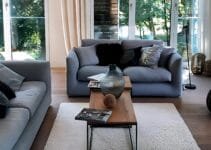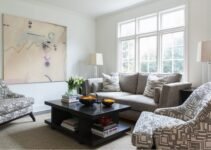Identifying your personal style is a crucial first step in creating a living room that feels authentic to you. Self-reflection plays a significant role in this process. Begin by examining your lifestyle, tastes, and the existing elements in your home decor. This introspection will help you understand what you truly enjoy and what will best serve your everyday needs.

Please, read our post and do not forget to check our YouTube channel “Grig Stamate”:
https://www.youtube.com/@GrigStamate
You will find there thousands of designing, furnishing, and decorating ideas for your home interior and outdoors.
Allow me to mention one of them:
The 50 MOST POPULAR Small LIVING ROOMS So Far in 2024 (video)
One effective method to discover your style preferences is by creating mood boards. Gather images, fabrics, color swatches, and other visual elements that resonate with you. This collection of inspirations can provide a clear picture of your aesthetic leanings. Explore different style inspirations by looking at interior design magazines, online platforms like Pinterest, and visiting showrooms or decor stores.
Distinguishing between what you like and what you need is essential. While you might be drawn to a particular style, it is important to consider its practicality and functionality within your living space. For instance, while minimalist designs are visually appealing, they might not be the best fit if you have a large family and require ample seating and storage.
Your fashion choices can also offer valuable insights into your interior style preferences. If your wardrobe is filled with classic, timeless pieces, you might lean towards a traditional or transitional living room style. Conversely, if you love bold patterns and colors in your clothing, a more eclectic or bohemian style might suit you.
Additionally, your hobbies and favorite places can inspire your living room design. If you enjoy reading, consider a cozy reading nook with comfortable seating and ample lighting. If you love the beach, incorporate coastal elements like light blues, whites, and natural textures. By reflecting on these personal aspects, you can create a living room that is not only stylish but also deeply personal and functional.
Exploring Popular Living Room Styles
When it comes to designing your living room, selecting the right style can significantly influence the ambiance and functionality of the space. Here, we delve into some of the most popular living room styles to help you find the one that best suits your taste and lifestyle.
Modern: Modern living rooms are characterized by clean lines, minimalistic decor, and a neutral color palette. Furniture tends to have sleek forms, often made from materials such as metal, glass, and leather. The emphasis is on simplicity and functionality, with an uncluttered look that exudes sophistication.
Traditional: Traditional style embraces classic design elements, rich colors, and an abundance of decorative details. Think of elegant furniture with curved lines, ornate woodwork, and luxurious fabrics. The color scheme often includes deep hues like burgundy, forest green, and gold, complemented by intricate patterns and textures.
Bohemian: Bohemian living rooms are vibrant and eclectic, reflecting a free-spirited and artistic vibe. This style is all about mixing various patterns, colors, and textures. Furniture is often vintage or second-hand, and the decor includes an array of global influences, such as Moroccan rugs, Indian tapestries, and African baskets. Plants, macramé, and an assortment of personal artifacts add to the room’s unique charm.
Scandinavian: Scandinavian design is synonymous with simplicity, functionality, and comfort. The color palette is predominantly light, featuring whites, grays, and pastel shades. Furniture is streamlined and often made from natural materials like wood. This style emphasizes coziness, with elements such as soft textiles, warm lighting, and minimalistic decor contributing to a serene atmosphere.
Rustic: The rustic style draws inspiration from nature and countryside living. It features raw, unfinished materials such as wood and stone. The color palette includes earthy tones like browns, greens, and beiges. Furniture tends to be robust and handcrafted, and decor elements often include vintage items, woven textiles, and natural accents like animal hides and botanical arrangements.
Industrial: Industrial living rooms are inspired by the look of warehouses and factories. This style is characterized by exposed brick walls, metal fixtures, and reclaimed wood. The color scheme is typically neutral, with a focus on grays, blacks, and metallics. Furniture is functional and often features a blend of modern and vintage pieces, creating a raw, edgy aesthetic.
By understanding these popular living room styles, you can better visualize how your space might look and feel, helping you make informed decisions about your decor and furniture choices.
Matching Styles with Functionality and Space
When choosing a living room style, it is essential to consider not only aesthetic preferences but also the practicalities of functionality and space. The size and layout of the room can significantly influence which style will work best. For instance, a minimalist style with sleek, space-saving furniture might be ideal for smaller living rooms, while larger spaces may accommodate more elaborate and luxurious styles, such as traditional or contemporary designs.
One crucial aspect to consider is the flow of movement within the room. Ensuring that there is ample space for easy navigation between furniture pieces can enhance the room’s usability and comfort. In smaller living rooms, opting for multi-functional furniture, such as ottomans with storage or sofa beds, can maximize space efficiency and maintain a clutter-free environment. For larger rooms, creating distinct zones for different activities, such as a reading nook or an entertainment area, can add both style and functionality.
The intended use of the living room should also guide your style selection. If the living room is primarily for entertaining guests, a style that promotes social interaction, such as a modern or industrial design with open seating arrangements, might be suitable. For those who use their living room as a personal retreat for relaxation, a cozy, rustic style with warm, inviting textures and comfortable furniture could be more appropriate. Multi-purpose living rooms, which serve various functions from working to family gatherings, benefit from adaptable styles like Scandinavian or transitional, which seamlessly blend form and function.
Lighting plays a pivotal role in enhancing the chosen style and functionality. Ambient lighting, such as ceiling lights and wall sconces, can provide general illumination, while task lighting, like floor lamps and table lamps, ensures adequate light for specific activities. Accent lighting, including LED strips and spotlights, can highlight architectural features or decorative elements, adding depth and character to the space.
Finally, consider storage solutions that complement the chosen style while keeping the living room organized. Built-in shelves, stylish cabinets, and decorative baskets can provide practical storage without compromising the room’s aesthetic appeal. By thoughtfully integrating functionality with style, you can create a living room that is not only visually pleasing but also adaptable to your needs.
Incorporating Personal Touches and Flexibility
Creating a living room that truly feels like home involves more than just adhering to a particular interior style. Personalizing your living space to reflect your unique personality and preferences is essential. Including personal touches like family photos, travel souvenirs, and DIY projects can significantly enhance the ambiance, making the room genuinely yours. Consider displaying a gallery wall of cherished memories or incorporating handmade items that hold sentimental value. These elements not only add character but also a sense of warmth and familiarity.
Another vital aspect of a well-designed living room is flexibility. Interior design is not a static endeavor; it evolves over time. Staying open to changes and updates ensures that your living room remains fresh and relevant. One practical approach is to update decor elements seasonally. Simple changes like swapping out throw pillows, blankets, or decorative accents can breathe new life into the space. For instance, lightweight fabrics and bright colors can be introduced in the summer, while cozy textures and warm tones are perfect for winter.
Keeping an eye on emerging trends can also inspire periodic updates. However, it’s crucial to integrate trends in a way that complements your existing style rather than overwhelming it. This could mean adding a trendy piece of furniture or experimenting with a new color palette. Additionally, investing in versatile and timeless furniture pieces can make it easier to adapt to various styles and trends without requiring a complete overhaul of your space.
Ultimately, the goal is to create a living room that is both stylish and reflective of you. By incorporating personal touches and remaining flexible with your decor, you can ensure your living space remains a comfortable and inviting sanctuary. Remember, interior design is an ongoing journey, and the most important aspect is that your living room feels like home to you.
Other related posts from our website:
https://howtobuildahouseblog.com/u-shaped-seating-area-the-pinnacle-of-living-room-comfort/
https://howtobuildahouseblog.com/the-50-most-popular-small-living-rooms-so-far-in-2024/
https://howtobuildahouseblog.com/small-living-big-style-modern-living-rooms-with-limited-space-4/
Thank you so much for your attention.
Stay tuned. We will upload many other amazing posts to our website and videos onto our YouTube channel.
Thank you so much.
for your time and attention.
Best Regards
See you to another post,
Bye, Bye



No Responses